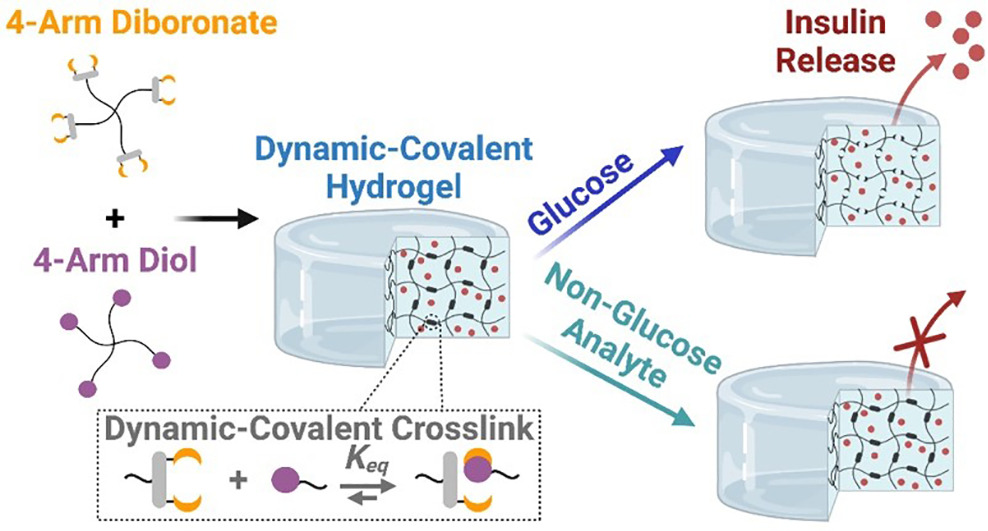Diboronate crosslinking: Introducing glucose specificity in glucose-responsive dynamic-covalent networks

Dynamic-covalent motifs are increasingly used for hydrogel crosslinking, leveraging equilibrium-governed reversible bonds to prepare viscoelastic materials with dynamic properties and self-healing character. The bonding between aryl boronates and diols is one dynamic-covalent chemistry of interest. The extent of network crosslinking using this motif may be subject to competition from ambient diols such as glucose; this approach has long been explored for glucose-directed release of insulin to control diabetes. However, the majority of such work has used phenylboronic acids (PBAs) that suffer from low-affinity glucose binding, limiting material responsiveness. Moreover, many PBA chemistries also bind with higher affinity to certain non-glucose analytes like fructose and lactate than they do to glucose, limiting their specificity of sensing and therapeutic deployment.
Highlights
• Typical glucose-binding motifs suffer from low affinity and specificity.
• Here, a diboronate motif is used to afford more specific recognition of glucose.
• Hydrogels made by diboronate crosslinking preferentially respond to glucose.
• Diboronate hydrogels offer more glucose-responsive insulin release.
• The responsiveness translates to more rapid blood glucose correction in vivo.
Here, dynamic-covalent hydrogels are prepared that, for the first time, use a new diboronate motif with enhanced glucose binding—and importantly improved glucose specificity—leveraging the ability of rigid diboronates to simultaneously bind two sites on a single glucose molecule. Compared to long-used PBA-based approaches, diboronate hydrogels offer more glucose-responsive insulin release that is minimally impacted by non-glucose analytes. Improved responsiveness translates to more rapid blood glucose correction in a rodent diabetes model. Accordingly, this new dynamic-covalent crosslinking chemistry is useful in realizing more sensitive and specific glucose-responsive materials.
Yuanhui Xiang, Sijie Xian, Rachel C. Ollier, Sihan Yu, Bo Su, Irawan Pramudya, Matthew J. Webber,
Diboronate crosslinking: Introducing glucose specificity in glucose-responsive dynamic-covalent networks,
Journal of Controlled Release, Volume 348, 2022, Pages 601-611, ISSN 0168-3659,
https://doi.org/10.1016/j.jconrel.2022.06.016.

